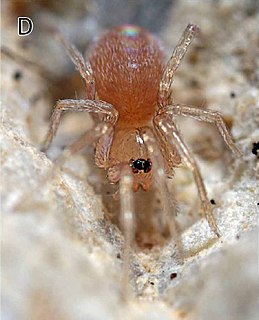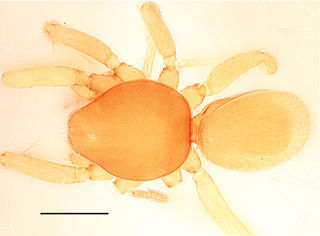
Oonopidae, also known as goblin spiders, is a family of spiders consisting of over 1,600 described species in about 113 genera worldwide, with total species diversity estimated at 2000 to 2500 species. The type genus of the family is OonopsKeyserling, 1835.

Unicorn ("one horn", in Latin) is a genus of goblin spiders from South America, containing seven species that occur predominantly in high elevation, semi-desert regions of Bolivia, Chile, and Argentina. Individuals are relatively large for goblin spiders, measuring up to 3.0 mm (0.12 in) in body length. The genus name refers to a characteristic pointed projection between the eyes and jaws of males. In at least one species, broken-off tips of the male pedipalps have been found within the genitalia of females, postulated as a means of sperm competition. Unicorn possesses several traits that suggest it is a relatively "primitive" member of the Oonopidae, and is classified with other similar, soft-bodied goblin spiders in the subfamily Sulsulinae.

Bannana is a genus of goblin spiders native to Xishuangbanna prefecture, Yunnan Province, China, where it lives in the leaf-litter of tropical rainforest. There are two known species: Bannana crassispina and B. parvula, both described in 2015. Individuals are pale yellow and unpatterned, and range from around 1.0 to 1.8 mm in body length, with females being slightly larger than males. The eyes are reduced or entirely absent. Known only from a nature reserve in Xishuangbanna, Bannana belongs to a group of Asian goblin spiders known as the "Dysderoides complex", that ranges from China to Pakistan and south to Indonesia.
Anophthalmoonops is a genus of spiders in the family Oonopidae found in Angola. It was first described in 1976 by Benoit. As of 2017, it contains only one species, Anophthalmoonops thoracotermitis.
Cortestina is a genus of spiders in the family Oonopidae. It was first described in 2009 by Knoflach. As of 2017, it contains only one species, Cortestina thaleri, found in Austria and Italy.
Cousinea is a genus of spiders in the family Oonopidae. It was first described in 2001 by Saaristo. As of 2017, it contains only one species, Cousinea keeleyi, found in the Seychelles.
Farqua is a genus of spiders in the family Oonopidae. It was first described in 2001 by Saaristo. As of 2017, it contains only one species, Farqua quadrimaculata, from the Farquhar Group islands of the Seychelles.
Hypnoonops is a genus of spiders in the family Oonopidae. It was first described in 1977 by Benoit. As of 2017, it contains only one species, Hypnoonops lejeunei found in Congo.
Hytanis is a genus of spiders in the family Oonopidae. It was first described in 1893 by Simon. As of 2017, it contains only one species, Hytanis oblonga, found in Venezuela.
Kapitia is a genus of spiders in the family Oonopidae. It was first described in 1956 by Forster. As of 2017, it contains only one species, Kapitia obscura.
Lucetia is a genus of spiders in the family Oonopidae. It was first described in 1983 by Dumitrescu & Georgescu. As of 2017, it contains only one species, Lucetia distincta, found in Cuba and Venezuela.
Megabulbus is a genus of spiders in the family Oonopidae. It was first described in 2007 by Saaristo. As of 2017, it contains only one species, Megabulbus sansan, found in Israel.
Nephrochirus is a genus of spiders in the family Oonopidae. It was first described in 1910 by Simon. As of 2017, it contains only one species, Nephrochirus copulatus, collected in Namibia.
Scaphios is a genus of spiders in the family Oonopidae. It was first described in 2010 by Platnick & Dupérré. As of 2017, it contains 8 species, all from Ecuador and Colombia.
Semibulbus is a genus of spiders in the family Oonopidae. It was first described in 2007 by Saaristo. As of 2017, it contains only one species, Semibulbus zekharya.
Setayeshoonops is a genus of spiders in the family Oonopidae. It was first described in 2011 by Makhan & Ezzatpanah. As of 2017, it contains only one species, Setayeshoonops setayeshoonops, found in Suriname.
Sulsula is a genus of spiders in the family Oonopidae. It was first described in 1882 by Simon. As of 2017, it contains only one species, Sulsula pauper, found in Algeria, Egypt, and Sudan.

Tapinesthis is a genus of spiders in the family Oonopidae. It was first described in 1914 by Simon. As of 2017, it contains only one European species, Tapinesthis inermis.
Himalayana is a genus of spiders in the family Oonopidae. It was first described in 2014 by Grismado. As of 2017, it contains 6 species from India and Nepal.
Khamiscar is a genus of spiders in the family Oonopidae. It was first described in 2015 by Platnick & Berniker. As of 2017, it contains 6 species, all found in Madagascar.



